|
|
|
Projects we could use some help with -most current:
-Grading Services
-Moving a
"fifth-wheel" trailer
*there is pay for these services. |
Projects/Wish List
Long-range:-New septic system
-Art Space / Propane Kiln
-Propane pool/spa heater
-Propane space heaters
-Laundry Shed |
posted September 28, 2012
Autumn time at Starland, cooler temperatures prevail,
but still sunny and warm during the day.
Soon we'll be fixing the roof at the "house" of
Starland... more to come about that.
We're hoping we can get some help from enthusiast...
we plan to offer food and drink for this "work" event. More info coming.
For now, Starland is still a serenity
offering place. The typical comment about Starland from visitors is how
"quiet it is" up here.
We all look forward to the house becoming more of a
"lodge" for the comfort and relaxation for our guests. As soon as the roof
is squared away, we can begin the interior remodeling.
Our pool solar system is not quite keeping up with
the cooler temps, but maybe someone can help us with this.
More later when Lobo doesn't have to run to work this
morning :-)
Enjoy life!
Oh, and O-yes, pool and spa are up and running.
 STARLAND
IS ENJOYING A REGULAR STREAM OF REGULAR AND NEW VISITORS... STARLAND
IS ENJOYING A REGULAR STREAM OF REGULAR AND NEW VISITORS...
posted 2/27/2011 by Lobo (Matrix)
Winter is supposed to be a slow time for Starland in as much as visitors,
but it has been quite the opposite! As Jesse, our semi-regular resident from New
York, left to go back for a few months until warmer weather returns to Starland.
Full-time residents Mohabee and MacGyver have been joined by yet another
semi-permanent resident, Craig. And joining them, Lobo and Stevie every weekend since
August, 2010. In just the last two weekends, a "Pair of Jacks" (Jack Rabbit and
Lord Jack Homo) have been visiting Starland discovering the many places to hike
within a fifty mile radius from Starland. Add "David for Now" who's joined us
this weekend.
David for Now relaxes with his shoes off and feet up while reading in the Sun
Room while it's windy and 40 degrees outside. Ah, the look of luxury.
ARTS & CRAFTS at STARLAND
posted 12/23/2010 by Lobo (Matrix)
Once again the Main Hall is converted to an Arts & Crafts activity
center.
Lobo and Steve set out to create custom holiday ornamental gifts. see more at
the
Pictures and Archive pages.
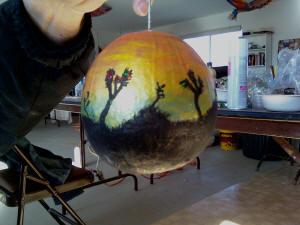
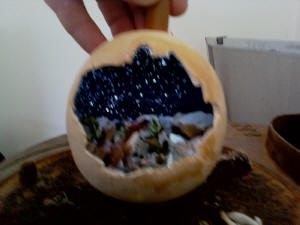
ROOF WORK
If you can help us out with the following materials, let us know.
We need tar paper, top roofing material, flashing, tar sealant, and nails. See
list below.
Email
Lobo
*** MATERIALS LIST FOR WHOLE
ROOF OVER HOUSE
1. “LOW ROOF” –over
front / office area (40X25)’=1,000 sq ft
a. 94’ of
flashing and maybe 32’ of inside corner flashing
2. “HIGH ROOF” –over
kitchen and bedroom areas (40X30)’=1,200 sq ft
a. 152’ of
flashing
2. “LOW ROOF” –over
garage/storage are (32X30)’=960 sq ft
a. 94’ of
flashing and maybe 40’ of inside corner flashing
TOTAL ROOF
AREA: 3,160 SQ FT.
TOTAL FLASHING:
340 FT.
TOTAL INSIDE FLASHING
72 FT.
SOLAR FOR SHOWER BUILDING: (“Long-ish”
term labor commitment)
(we have most all of the
materials –‘may need sections of copper pipe)
A. Labor to trench between solar collector and
electric water heater.
B. Laying (“sweating”) in supply
and return copper piping in trench between solar collector and electric water
heater.
INTERIOR -HOUSE:
(LOTS OF MOOLA)
–WIRING
–INSULATION
–DRY-WALL
-FINISHING
EXTERIOR -HOUSE:
(LOTS OF MOOLA)
–EAVES
–CABLE/WIRE RE-ROUTING
–FINISHING
SEPTIC SYSTEM FOR “LOWER STARLAND” (LOTS OF MOOLA)
POOL
(LOTS OF MOOLA)
IRRIGATION
PAVEMENT -DRIVEWAY
May 24, 2009 by Lobo (Matrix)
revised 2/27/2011
One of Starland's endeavors involves installing a second septic system on the
land for expanding food service... as "throngs" are expected to flock to
Starland in "some kind" of near future. We/I am exploring a means to build our
own system. Some say, "Don't do it." I say, "Why not?"
But today, I'm trying to post an article on septic systems I found in a mag I
picked up from Home Depot, it's called "Green Builder" ("Defining Green" March
2009 issue) ... see the article "Flush and Forget" at
www.greenbuildermag.com. I found
this article very informative... and Starland needs another septic system... I'm
wondering what it would take to put a "good" one in that is ultimate
green-friendly. The article gives several designs.
Awesome sight for research: http://toolbase.org/
Here's my attempt to display the article at this website...
click here "Flush &
Forget"
In the mean time I'm researching if it's possible to build our own septic
system.
'Very comprehensive septic system design..
Link
Food for thought from...  
Homemade Septic Tank Page
Homemade septic tank information:
If you are going to install a homemade septic tank you will need to learn 3
things:
· Depth of the seasonal water tables.
· Perk rate of your soil.
· Your state and local code requirements.
The code requirements are easily obtained from your health or zoning office.
However I will warn you they are not the easiest documents to translate. The
water tables and perk rates are not so easy to get because these tests have to
be performed on the property and unless you have done soil borings or perk tests
before I would STRONGLY suggest hiring a certified septic designer to perform
these tests. This will cost you $200 to $500 but is well worth the investment if
you are going to to it yourself.
I have seen many times where the homeowner has gone through the time and trouble
to install a homemade septic tank only to have the state inspector show up after
the job is done and tell them the system is not up to code and it will have to
be re-done. Not a fun thing to have happen, particularly when they often will
not let them live in the house until the replacement system is installed. Best
to have a professional involved that can help prevent these errors.
The soil borings will tell you how deep you can have your drainfield (you will
need 3 to 4 feet of dry soil between the bottom of your drainfield and the
seasonal water tables) and the perk rate will tell you at what rate the soil
will take water (if the soil perks too slow, the home will put out water faster
than the soil can accept it causing overloading, if it perks too fast the sewage
will not be properly treated). Once you have this information you can get
started.
When you know where you are going to install the homemade septic tank, stake off
the area to prevent heavy equipment from driving over the ground and compacting
the soil. I always suggest over-building your system. If you have a 2-bedroom
house (the number of bedrooms are what is used to gauge the size of a septic
system. 75 gals per day per person. Potentially 2 people per bedroom=150 gals
per day. 3 bedroom home=450 gals per day) you should build the system for 3
bedrooms...3 bedrooms, size it for 4, etc. You will also want to factor in other
information into the size of the system, i.e. daycare or beauty salon operating
in the home, frequent entertaining, etc.
Before you say this will add a lot of money, understand this, the biggest cost
of a septic system is A tank and drainfield, not the size of the tank and
drainfield. To increase the size of a system to the next level will usually only
add a few hundred dollars.
The minimum size of the tank should be 1,000 gallons, preferably 1,250 or 1,500
gallons. Two 1,000-gallon tanks are even better (the more tank area you have for
settling the better). Install an effluent filter in the exit baffle just after
setting the tank.
The drainfield should be made up of 4 to 6 legs.” Longer shallow trenches are
better than short and deep because you get more evaporation. I prefer trenches
be 24” to 36” wide and 24” deep, 12” of 3/4“ to 1½” rock, 4” PVC distribution
pipe with ½” holes, cover the pipe up with 2” of rock, cover with geo-tech
fabric (to keep the top soil from filtering down into the drainfield trench),
then cover with top soil. The trenches should be 25’ to 100’ long. The bottom of
the trench and the pipes should be level or no more than 4” of slope per 100’
(you don’t want the effluent to flow downhill and load up one end). Chambers are
also a great alternative to using rock.
If you are on flat land you will want to use a distribution box where the
individual lines branch out from. On flat land you will also want to crown the
area over the drainfield to divert rain and snow melt.
On sloping land you will want to use a drop box system. This is where the
trenches are perpendicular to the slope, when the first trench fills up the
effluent spills over to the next trench located 6’ to 10’ further down the hill,
then to the next trench and so on.
Note: Many states now require you include an area for the replacement drainfield
(when the first one fails) when you design the system. Instead of just designing
it on paper, save the (future) higher labor/material costs and put it in now.
Then use a diverter valve to switch from one field to the other every few years.
The tank should be a minimum of 10’ from the house and the drainfield should be
100’ away from the well (FHA regulations), 50’ to 75’ away from a body of water
and a minimum of 10’ away from lot lines. You also want the tank as shallow as
possible for ease of servicing…you do not want to dig 6 feet every time you want
to pump/inspect the tank. Of course these guidelines are based on a typical
system. If you need an engineered system because you have heavy clay that won’t
perk or high water tables you are opening up a whole can of worms.
Find a good designer, have them do the soil tests and get their advice. Also
make friends with the local inspector...tell him you want his/her help with your
system. If you come across like a know-it-all-jerk he/she will not go out of
their way to help you and can make your life a living hell.
At any rate, once you get your system installed make sure you start using it
properly. Failing septic systems are a widespread problem in the US & very
costly to homeowners, with replacement costs often running from $5,000 to
$20,000 or more. For more information, you can go to
http://www.laundry-alternative.com/septic_system_maintenance.htm
This article borrowed from website URL:
http://www.laundry-alternative.com/homemade_septic_tank
If you can do this... you need to contact Starland :-) !!!
-email Lobo
#1 Construct a small septic system:
http://www.wikihow.com/Construct-a-Small-Septic-System
#2 Eco-nomic:
http://www.eco-nomic.com/septic.htm
#3
small link.
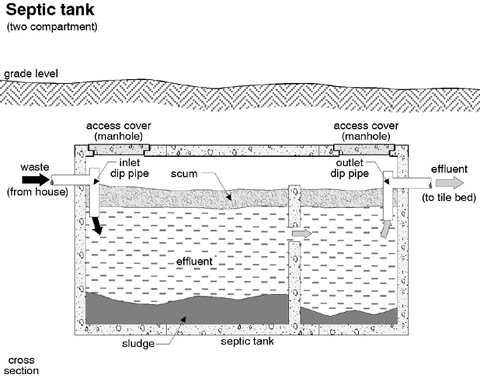 What
is a Septic Tank? What
is a Septic Tank?
Septic Tanks are the ideal, economical and trouble free sewage bio-digesters. It
is believed the septic tank system was first introduced to South Africa by the
British military in 1898. The term �septic� refers to the anaerobic bacterial
environment that develops in the tank and which decomposes the waste discharge
into the tank. A septic tank is basically a vessel buried underground, the
purpose of which is the collection, storage, and to some limited extent,
treatment of sewage. A typical septic tank system normally operates by gravity,
and consists of a tank and a soakaway drain. Untreated waste water from a
property flows into the septic tank, where the solids separate from the liquids.
Some solids, such as soap scum or fat, will float to the top of the tank to form
the scum layer. Heavier solids settle to the bottom of the tank as sludge. Self
forming bacteria in the tank help the system digest these solids or sludge where
a natural process of anaerobic decomposition occurs in the tank which reduces
the amount of solid matter and provides some treatment of the waste. The
remaining liquids flow out of the tank to a soakaway and eventually get taken up
through the root system of plants or added to the groundwater. Baffles built
into the tank hold back the floating scum from moving past the outlet of the
tank.
Septic tank care is crucial to maintain a healthy septic system. Although the
septic system is quite self sufficient, there are things you can do to help the
system work efficiently. Microbes in your septic system will naturally break
down the organic material that drains into your septic tank. The broken down
material will naturally drain out of the septic tank and into the soakaway.
There are some solids that cannot drain out of the septic tank and this is
normal. Regular septic tank care requires you to desludge these solids every 3 �
5 years. The size of your septic tank, the amount of use and the kind of
products you allow into your drains will determine how often your septic tank
will need to be desludged.
What not to put in your septic tank?
Uncontrolled use of disinfectants or chemical cleansers, especially as is often
the case at institutions such as hospitals, schools and hotels, may inhibit the
natural bacterial activity. Industrial or other potentially toxic effluent
should not be allowed into septic tanks.
Coarse, non-degradable solids such as coffee grounds, cigarette butts, facial
tissues, plastic bags, bottle tops, sanitary towels and nappies, must NOT be
deposited into the septic tank.
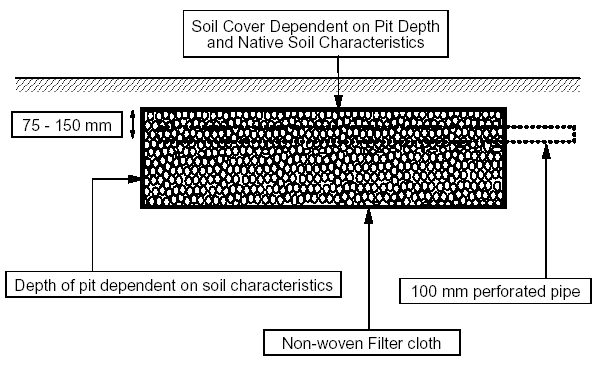 What
is a Soakaway? What
is a Soakaway?
The soakaway is an underground soil treatment system, which receives partially
treated sewage from the septic tank. The soil on a site must be suitable for a
soakaway to work properly. Soil that is too coarse, too fine or impermeable, can
limit the effectiveness of the treatment system. It is imperative that effluent
from a septic tank is not discharged into a river, vlei, etc as it is by no
means, in terms of health, fit for animal or human consumption. The size of your
septic tank soakaway is determined by the size of your septic tank and the size
of your dwelling. It cannot be built near any open water such as a river or vlei
because of the possibility of seepage from the soil into the water.
What is a Conservancy Tank?
A conservancy tank is any covered tank without an overflow which is used for the
reception and temporary retention of sewage and that requires routine emptying
at intervals.
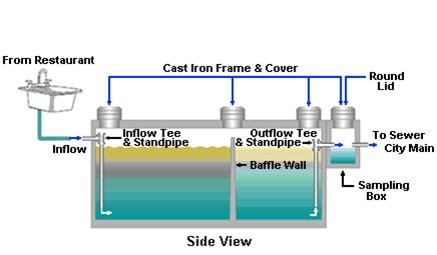 What
is a Grease Trap? What
is a Grease Trap?
Grease traps are commonly used on the waste pipe from the kitchen, with the
object of removing as much grease and fat as possible. Grease traps have special
merit at a restaurant or kitchen where excessive amounts of fat and oil are
likely to be released, which may cause accretions in the sewers or rapid
accumulation in the septic tank. In a household the amount of solid matter
contributed by the kitchen nowadays is quite considerable and it certainly seems
worthwhile to remove the fatty material, as it would reduce the quantity and
tenacity of the scum formed in the tank.
The proper function of a grease trap is very much dependant on the regularity
with which it is cleaned. The design and construction of grease traps should
provide for conditions, which are suitable to allow the fat in suspension to
rise and collect at the surface.
#4
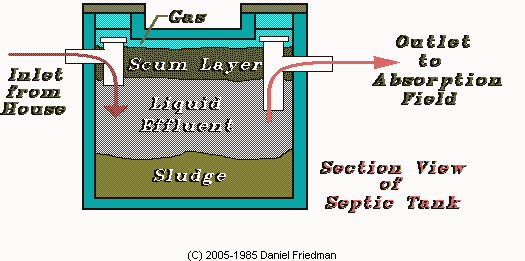
#5
County Requirements: Minimum Septic Tank Size = 1000
gallons
3 bedrooms = 1000 gallon tank
4 bedrooms = 1200 gallon tank
5 bedrooms = 1500 gallon tank
Policy: Determining What is a Bedroom for the Purpose of Individual Sewage
Disposal Systems Requirements
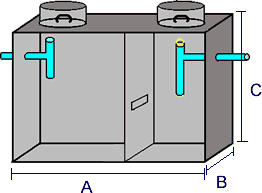 |
Tank Construction:
|
Size
|
A
|
B
|
C
|
Actual Cu. Feet
|
Actual Gallons
|
|
1000
|
8'
|
4'8"
|
6'
|
131.9
|
987
|
|
1200
|
8'
|
5'8"
|
6'
|
164.9
|
1234
|
|
1500
|
9'6"
|
5'8"
|
6'
|
198.8
|
1486
|
|
2000
|
16'
|
4'8"
|
6'
|
275.9
|
2064
|
|
|
